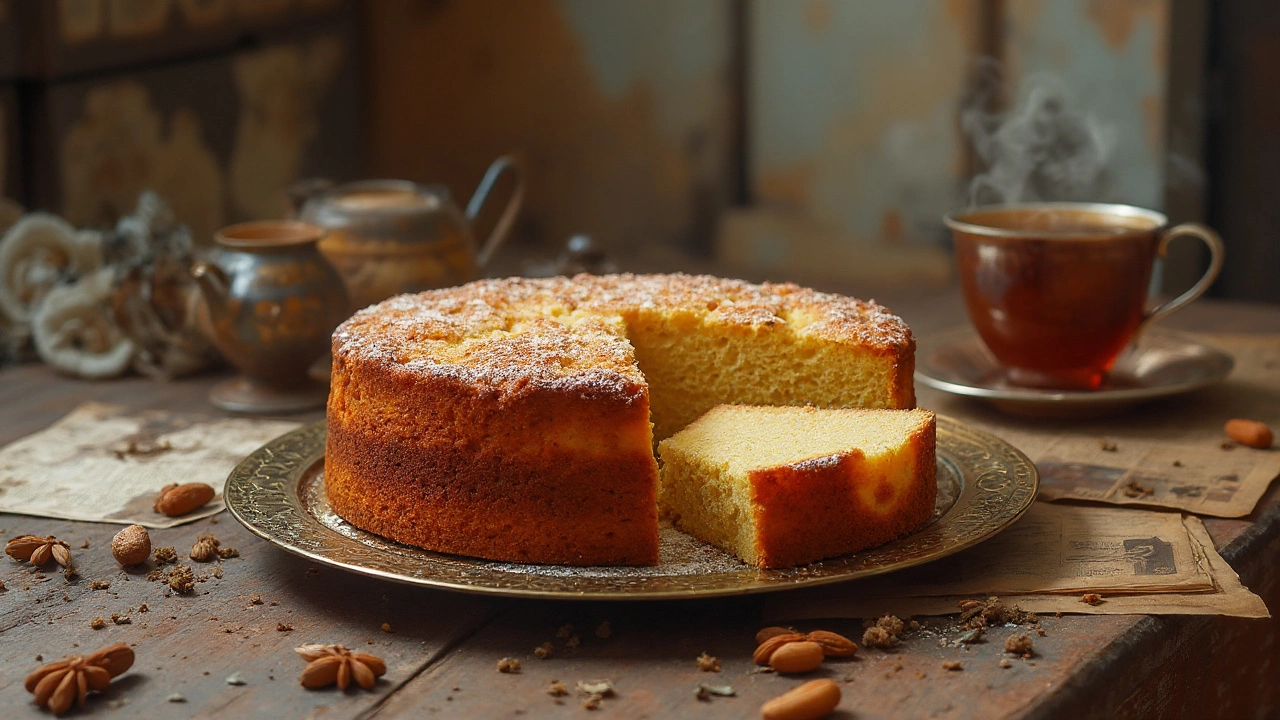Imagine handing a friend a piece of cake and telling them it's called 'miserable.' They’d probably pause, maybe laugh, and then take a curious bite anyway. That’s the vibe miserable cake gives off—its name is a conversation starter before you even slice into it. Even more puzzling? This pastry is so good it’s hard not to smile with each mouthful. Why would anyone call something so delicious 'miserable?' It sounds like a cruel culinary joke, but there's a real, tangled story behind the name. Let’s break it down, one almondy bite at a time.
The Origins: How a Delicious Cake Got Such a Gloomy Name
The panic around the name 'miserable cake' is real. It’s just one of those things that make you stop and wonder, like why a black forest cake isn’t made in a forest or if Boston cream pie is actually a pie. Miserable cake is a French invention—more specifically, it comes from the Belgian and French regions where almond cakes are practically a birthright. The French call it 'gâteau Miséreux' or just 'Miserable.'
A couple hundred years ago, peasants and regular folks made cakes with what they had on hand—mainly eggs, sugar, and sometimes ground almonds. Butter and rich fillings? Rare, if available at all. The term 'miserable' didn’t mean the cake tasted bad; it reflected the cake’s humble, almost sparse origins. The everyday people of the era, lacking the butter-laden luxury of aristocratic pastries, settled for something simpler yet satisfying. The name stuck, a nod to the 'miserable' financial state of its inventors, not the cake itself.
The recipe slowly got fancier over the years. By the 20th century, Belgians and some French bakers elevated miserable cake by adding a creamy mousseline filling, making it oddly luxurious for something with a sad name. The cake lost some of its original rough edges, but the story behind it stayed intact. It’s one of those cases where a name hangs on longer than the ingredients, just because it’s so memorable.
There are whispers that 'miserable' also refers to how tricky it is to make. The sponge layer, loaded with whipped egg whites and ground almonds, can be a nightmare for novice bakers: temperamental, requiring a light hand, and prone to collapse if you overmix. Some bakers have joked it’s 'miserable' to make because the cake is so delicate.
Inside the Recipe: What Makes Miserable Cake Different?
Miserable cake isn’t just another almond-flavored sponge. It plays a subtle game with texture and flavor, and people remember it for that silky, nutty crumb. The cake itself is built mainly on ground almonds (or almond flour), whipped egg whites, sugar, and just a pinch of flour. No heavy flour or buckets of butter to weigh it down.
Classic miserable cake uses what's called a 'biscuit Joconde' style sponge. Instead of fluffy, lifted cakes you might see in modern baking, this one comes out moist and a bit chewy, almost like a light marzipan slab. All those egg whites give it structure and keep it airy. It’s gluten-free by design—a nice perk for anyone with wheat sensitivities.
But where miserable cake truly takes off is the filling. The traditional version is sandwiched with mousseline cream—a blend of pastry cream and soft butter that gets whipped until fluffy. Some variants sneak in coffee, orange zest, or even a spash of rum for depth. At the end, a light dusting of powdered sugar gives it a gentle, inviting look, belying its somber name.
If you’re looking for modern tweaks, you can swap the filling for praline cream, lemon curd, or chocolate ganache and still keep that classic texture and flavor alive. Just don’t overload the cake with frosting; it’s meant to be subtle, not overloaded. This isn’t a dessert that needs a parade of toppings or sprinkles. Simplicity is the main character here.

When and Where Is Miserable Cake Eaten?
Miserable cake lives a double life. You’d expect something with that name to be reserved for sad days, but it actually makes its appearance at birthdays, family gatherings, cafés, and pastry shops, especially in Belgium and northern France. It’s the kind of cake that pops up when you want to treat yourself with something humble but undeniably charming.
In Belgium, miserable cake is a staple alongside coffee. Walk into a Brussels bakery or patisserie, and you’ll spot it lined up alongside eclairs and fruit tarts, sometimes with a handwritten label that dares you not to ask about its gloomy name. In France, especially in Lille and regional towns near Belgium, you’ll see it during holiday feasts and as a weekend treat at the family table.
One remarkable story from the 1960s gives miserable cake a spot in pastry lore. A bakery in Liège won a regional award for best cake with a misérable recipe, cementing its place in Belgian hearts. Since then, it’s had a small revival, reminding people that good things come from simple beginnings—even if they sound depressing on paper.
| Occasion | Region | Serving Style |
|---|---|---|
| Birthdays | Belgium, Northern France | Sliced with coffee |
| Family Gatherings | Belgium | Platter with fruit |
| Pâtisserie Counters | France | Single portions |
Miserable cake’s reputation has quietly evolved over the decades. What began as a survival dessert—a way to stretch a few eggs and nuts into something sweet—turned into a nostalgic comfort food. These days, it’s trending with people who want classic flavors and fewer processed ingredients. Grain-free and gluten-free diets have also helped put miserable cake back on the map because the sponge is *naturally* wheatless. You could say miserable cake is, ironically, a feel-good favorite for anyone who wants homemade food with a story attached.
How to Bake Miserable Cake at Home: Not So Miserable After All
Baking a miserable cake isn’t hard once you have the right technique, but you do need patience and a light hand. Here’s how I do it, with every tip learned from trial, error, and a few kitchen meltdowns:
- Miserable cake needs good ingredients: fresh eggs, real almond flour (not almond meal), superfine sugar, and good-quality unsalted butter for the filling. Don’t wing it with leftovers.
- The key trick is whipping the egg whites until stiff. This gives the sponge its structure. Make sure your bowl is squeaky clean and there’s no yolk present, or your whites won’t whip properly.
- Fold the ingredients together gently. Overmix, and your batter will deflate, turning dense and chewy, which nobody wants.
- Bake in a lined rectangular tin at 350°F (180°C) until golden and just firm to the touch—about 25 minutes, sometimes less depending on your oven.
- While the cake cools, whip up your mousseline cream. Cook a basic custard from egg yolks, milk, sugar, and cornstarch; let it cool to room temperature, then whisk with softened butter until it turns pale and fluffy.
- Cut the cake in half (lengthwise), spread a thick layer of cream, and gently sandwich the layers. Chill for at least two hours to let the flavors mingle and the cream set.
- A dusting of powdered sugar on top is the traditional finish, but you can add a sprinkle of toasted almonds for a little crunch.
If you’re short on time, you can prep the layers a day in advance. Just keep the cream and cake separate until you’re ready to assemble. Freezing the whole cake works fine too, as long as you wrap it tightly (I use a double layer of plastic wrap and foil). Thaw overnight in the fridge, and serve at room temperature for the best texture and flavor.
If you’re feeling bold, try flavoring your mousseline with coffee extract, lemon zest, or even a little kirsch for a grown-up kick. Miserable cake is a blank canvas once you have the basics down.

Fun Facts, Variations, and the Magic of a Sad-Sounding Sweet
Most folks have never heard of miserable cake outside of Belgium or French pastry circles. But those who have almost always remember their first bite—the light, nutty crumb, the gentle sweetness, and the silky cream. It's survived wars, diet trends, and the relentless pressure to be something fancier. There’s a quiet, old-world charm in its refusal to become a sugar bomb or trendy Instagram dessert.
This quirky cake has more than a few surprises:
- The traditional recipe is gluten-free, way before gluten-free was a health craze.
- French and Belgian grandmothers have handed down their family recipes for miserable cake for generations—some even guard the exact mousseline proportions like state secrets.
- ‘Miserable’ is sometimes spelled ‘misérable’ when you’re digging up old French cookbooks. Don’t get confused—they’re the same cake.
- A slice contains around 250-300 calories, depending how generous you are with the cream.
- Modern bakers play with versions using pistachios, hazelnuts, or flavoring the cream with raspberry or orange flower water.
For anyone on a health kick, miserable cake isn’t just tasty—it’s a smarter dessert option compared to thick frosted layer cakes. Less sugar, zero wheat, and a better ratio of protein because of all those eggs and nuts. Swap in a slightly lighter filling, like whipped Greek yogurt mixed with a dash of honey, for an even healthier riff.
If you’re stuck with leftover egg yolks after whipping all those whites? Make lemon curd or your own version of pasta carbonara right after baking. Waste nothing. That’s the miserable cake spirit—making something special out of what you already have handy.
At the end of the day, miserable cake wears its odd name with pride. It’s living proof that you can turn a few basic things into something that surprises everyone—your taste buds included. Maybe that’s why people admit to falling for it, despite the gloomy first impression. A cake called 'miserable' that makes you smile? Only in the world of good desserts would that make perfect sense.